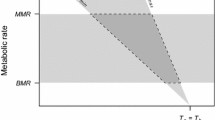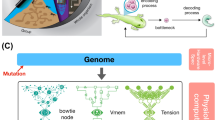Abstract
Generating developmental gradients by temperature gradients established within a developing organism is an easy, non-invasive technique to study physiological interdependencies between locally separated subsystems. A linear temperature gradient of about 10° C/mm was maintained up to 5 h in either direction along the long axis of a long-germ-type hymenopteran egg, which was simultaneously filmed by the 16 mm timelapse technique. The result was a dramatic desynchronization of development, which between the egg poles could reach up to 9.3 h relative to normal development. Within the same egg, up to seven mitotic waves (i.e. eight different nuclear generations) were observed at the same time, and the subsequent cellularization process was extremely asynchronous. The “initial regions” of the mitotic waves, the “fountain flow” of the ooplasm, and the gastrulation process were shifted towards the egg pole kept at higher temperatures. Developmental processes occurring successively in normal development now took place simultaneously, with either direction of the temperature gradient. For instance, while gastrulation had started in the warm region, midblastula transition and cellularization were in progress in the middle of the egg, and intravitelline nuclear multiplication occurred at the cold pole, by rapid and still biphasic cell cycles. In some respects, development resembled that of a short-germ-type insect egg. Nevertheless, the developmental processes were resynchronized after the temperature gradient was switched off. Surprisingly, the extreme desynchronization during early development did not affect the segment pattern of the resulting embryos. The technique of inducing well-defined developmental asynchronies might be applied in Drosophila to analyse the subtle interplay between maternal and zygotic gene activities described in this species.
Similar content being viewed by others
References
Akam M (1987) The molecular basis for metameric pattern in the Drosophila embryo. Development 101:1–22
Brentrup D, Wolf R (1993a) Parabiotic development of fused eggs from the Hymenopteron, Pimpla turionellae, and of eggs injected with energids. Roux's Arch Dev Biol 203:44–50
Brentrup D, Wolf R (1993b) Pattern formation fails after blastoderm formation by rapid cell cycles in an artificially activated insect egg. Roux's Arch Dev Biol 203:51–59
Bruhns E (1974) Analyse der Ooplasmaströmungen und ihrer strukturellen Grundlagen während der Furchung bei Pimpla turionellae L. (Hymenoptera). I. Lichtmikroskopisch-anatomische Veränderungen in der Eiarchitektur koinzident mit Zeitrafferfilmbefunden. Roux's Arch Dev Biol 174:55–89
Driever W, Nüsslein-Volhard C (1988) A gradient of bicoid protein in Drosophila embryos. Cell 54:83–93
Fleischmann G (1975) Anlage und embryonale Entwicklung fertiler Gonaden mit und ohne Polzellen bei Pimpla turionellae L. (Hymenoptera, Ichneumonidae). Zool Jahrb Alit Anat Ontog Tiere 94:375–412
Foe VE, Alberts BM (1983) Studies of nuclear and cytoplasmic behaviour during the five mitotic cycles that precede gastrulation in Drosophila embryogenesis. J Cell Sci 61:31–70
Glover DM (1992) Transitions in cell cycle regulation in Drosophila development. Eur J Cell Biol Suppl 36:25
Grandin N, Charbonneau M (1991) Cycling of intracellular free calcium and intracellular pH in Xenopus embryos: a possible role in the control of the cell cycle. J Cell Sci 99:5–11
Gull K (1991) From fungi to flies: pattern and form in the cell cycle. Current Opin Cell Biol 3:247–252
Hülskamp M, Tautz D (1991) Gap genes and gradients — the logic behind the gaps. BioEssays 13:261–268
Ingham PW (1988) The molecular genetics of embryonic pattern formation in Drosophila. Nature 335:25–34
Ingham PW, Nakano Y (1990) Cell patterning and segment polarity genes in Drosophila. Dev Growth Differ 32:563–574
Jackle H, Sauer F (1993) Transcriptional cascades in Drosophila. Current Opin Cell Biol 5:505–512
Kirschner M (1992) The cell cycle then and now. Trends Biochem Sci 17:281–285
Krause G (1987) Evolutionary shifts indicated by the time pattern of embryo-genetic events in Pimpla (Hymenoptera) as compared with Tachycines (Orthoptera). Zool Jahrb Abt Anat Ontog Tiere 116:453–472
Lacalli TC, Harrison LG (1991) From gradient to segments: Models for pattern formation in early Drosophila embryogenesis. Semin Dev Biol 2:107–117
Meer JM van der (1990) Control of mitosis and ooplasmic movements in insect eggs. In: Malacinski GM (ed) Cytoplasmic organization systems. McGraw, New York, pp 263–293
Murray AW, Kirschner MW (1989) Cyclin synthesis drives the early embryonic cell cycle. Nature 339:275–280
Nagy LM, Carroll S (1994) Conservation of wingless patterning functions in the short-germ embryos of Tribolium castaneum. Nature 367:460–463
Niemuth J (1991) Experimentelle Desynchronisierung von Entwicklungsprozessen im Ei der Schlupfwespe Pimpla turionellae L. durch steile, lineare Temperaturgradienten. PhD Thesis, Würzburg University, Germany
Pankratz MJ, Jäckle H (1993) Development of Drosophila. Cold Spring Harbor Laboratory Press, Bate and Martinez Series
Patel NH, Condron BG, Zinn K (1994) Pair-rule expression patterns of even-skipped are found in both short- and long-germ beetles. Nature 367:429–434
Rothe M, Pehl M, Taubert H, Jackle H (1992) Loss of gene function through rapid mitotic cycles in the Drosophila embryo. Nature 359:156–159
St Johnston D, Nusslein-Volhard C (1992) The origin of pattern and polarity in the Drosophila embryo. Cell 68:201–219
Went DF, Krause G (1974) Alteration of egg architecture and egg activation in an endoparasitic Hymenopteran as a result of natural or imitated oviposition. Roux's Arch Dev Biol 175: 173–184
Wolf R (1978) The cytaster, a colchicine-sensitive migration organelle of cleavage nuclei in an insect egg. Dev Biol 62:464–472
Wolf R (1985) Migration and division of cleavage nuclei in the gall midge, Wachtliella persicariae. III. Pattern of anaphase-triggering waves altered by temperature gradients and local gas exchange. Roux's Arch Dev Biol 194:257–270
Wolf R, Krause G (1971) Die Ooplasmabewegungen während der Furchung von Pimpla turionellae L. (Hymenoptera), eine Zeitarafferfilmanalyse. Roux's Arch Dev Biol 167:266–287
Wolf R, Nuss E (1976) Artificial rearrangements of insect ooplasm caused by fixation and their microkymographic recording. Roux's Arch Dev Biol 179:197–202
Wolf R, Wolf D (1974) Aufbau und Aufrechterhaltung steiler Temperaturgradienten in entwicklungsbiologischen Objekten bei gleichzeitiger lichtmikroskopischer Filmregistrierung. Roux's Arch Dev Biol 175:249–252
Wolf R, Wolf D (1988) Activation by calcium ionophore injected into unfertilized ovarian eggs explanted from Pimpla turionellae (Hymenoptera). Zool Jahrb Abt Allg Zool Physiol Tiere 92:501–512
Yasuda GK, Schubiger G (1992) Temporal regulation in the early embryo: is MBT too good to be true? Trends Genet 8:124–127
Author information
Authors and Affiliations
Rights and permissions
About this article
Cite this article
Niemuth, J., Wolf, R. Developmental asynchrony caused by steep temperature gradients does not impair pattern formation in the wasp, Pimpla turionellae L.. Roux's Arch Dev Biol 204, 444–452 (1995). https://doi.org/10.1007/BF00360852
Received:
Accepted:
Issue Date:
DOI: https://doi.org/10.1007/BF00360852




